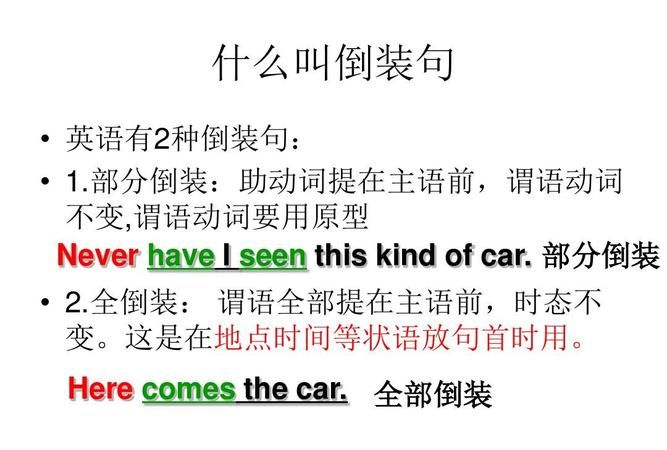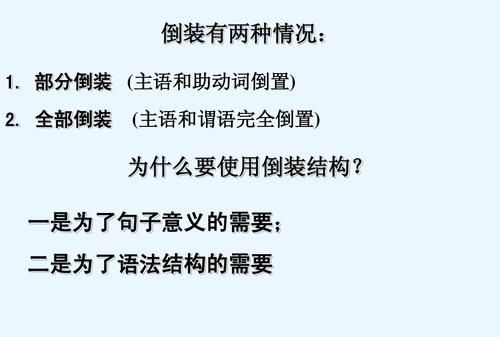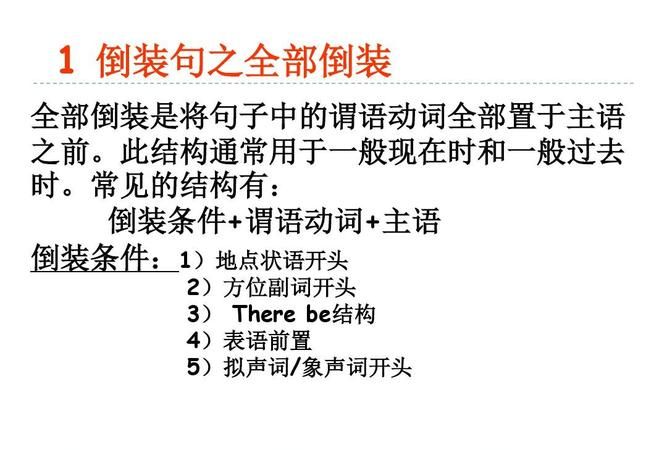本文目录
英语倒装句中主语是名词时
应该说是主语是代词时不倒装,例如:Out
he
rushed.
或There
it
comes!
here
you
are因为主语是代词,所以没倒装。

英语倒装句12种类型及例句初中
英语倒装句12种类型:
1、“there be”结构 在这一结构里,there是引导词,主语在be后。
There is a box on the table. 桌子上有个盒子。
2、疑问句 疑问句为倒装形式。
Is she singing in the classroom? 她是不是正在教室里唱歌?
3、here、there等副词开头的句子(部分)
在here、there等副词开头的某些句子中(要用一般现在时态)(前两个例句);如果主语是人称代词,主语和主要动词的词序不变。(完全倒装)(最后一个例句)
There goes the bell. 铃响了。
4、重复倒装句型
在以so、nor、neither开头,表示谓语所述的情况也适用于另一个人或一事物的肯定或否定句中。so用于肯定句,表示“也一样”、“也这样”;nor、neither用于否定句,表示“同样也不,也不这样”。
I am watching TV. So is she. 我在看电视,她也是。
5、直接引语的全部或一部分放在句首时,主句中的主谓也常直接倒装(完全倒装)
"Very well," said the French student. “很好”,那个法国学生说道。
6、否定副词开头的句子(部分倒装)
在以never、little、hardly、not
only、few、not、seldom等否定副词开头的句子中,采用部分倒装;如果不放在句首就不要倒装。
Little did he say at the meeting.在会上他没说话。

7、以only所修饰的副词、介词短语或状语从句的句子
Only when the war was over in 1918 was he able to get happily back to work. 只有1918年战争结束,他才能开心地重归工作。
8、地点、方位副词在句首 (完全倒装)
为了表达生动,有时把表地点、方位的副词,如
up、down、out、away、in等放在句首,同时把谓语动词放在主语之前。若主语为人称代词,主语和谓语动词的位置不变,只将副词放在句首。(完全倒装)
Away hurried the boy. 男孩匆忙走开了。
9、虚拟结构中
在虚拟结构中,条件从句的谓语含有were、had 和should这三个词是,可省去if,将这些词移至主语之前。
Had I time (= If I had time), I would go and help you. 如果我有时间,我会去帮助你的。
10、as 引导的让步状语从句
as引导让步状语从句时要倒装(形容词/ 副词/ 名词/ 动词 + as + 主语 + 谓语)。
Proud as they are, they are afraid to see me. 他们很傲慢,但是也害怕看到我。
11、祝愿的句子
用于某些表示祝愿的句子里。
May you succeed! 祝你成功!
12、So + 形容词、副词及such 置于句首时
So happy did he feel. 他感觉非常开心。
半倒装句和全倒装例句
1、全bai部倒装
1) here, there, now, then, thus等副词置于句首, 谓语动词常用be, come, go, lie, run等表示来du去或状态的动zhi词。例如:
Then came the bus. Here is your letter.
2) 表示运动dao方向的副词或地点状语置于句首,谓语表示运动的动词。
Out rushed a boy。
Ahead sat an old woman.
但如果主语是人称代词,不能要倒装,比如:Here you are. Away they went.
2. 部分倒装
1) 句首为否定或半否定的词语,如no, not, never, seldom, little, hardly, at no time, in no way, not until… 等。
Never have I seen such a performance.
Not until the child fell asleep did the mother leave the room.
当Not until引出主从复合句,主句倒装,从句不倒装。注意: 如否定词不在句首不倒装。比如:I have never seen such a performance.
The mother didn't leave the room until the child fell asleep.
2)否定词开头作部分倒装
如 Not only…but also, Hardly/Scarcely…when, No sooner… than等,要倒装。例如:
Not only did he refuse the gift, he also severely criticized the sender.
Hardly had she gone out when a student came to visit her.
No sooner had she gone out than a student came to visit her.
3) so, neither, nor作部分倒装
用这些词表示"也"、"也不" 的句子要部分倒装。例如:
Tom can speak French. So can Jack.
If you won't go, neither will I.
4)only+ 副词/介词/状语从句位于句首,要部分倒装
Only in this way, can you learn English well.
Only after being asked three times did he come to the meeting.
如果句子为主从复合句,则主句倒装,从句不倒装。
Only when he is seriously ill does he ever stay in bed.
5)as, though 引导的倒装句
as / though引导的让步从句必须将表语或状语提前(形容词, 副词, 分词, 实义动词提前)。但需注意:

完全倒装和不完全倒装的结构
1、全部倒装
1) here, there, now, then, thus等副词置于句首, 谓语动词常用be, come, go, lie, run等表示来去或状态的动词。例如:
Then came the bus. Here is your letter.
2) 表示运动方向的副词或地点状语置于句首,谓语表示运动的动词。
Out rushed a boy。
Ahead sat an old woman.
但如果主语是人称代词,不能要倒装,比如:Here you are. Away they went.
2. 部分倒装(不完全倒装)
1) 句首为否定或半否定的词语,如no, not, never, seldom, little, hardly, at no time, in no way, not until… 等。
Never have I seen such a performance.
Not until the child fell asleep did the mother leave the room.
当Not until引出主从复合句,主句倒装,从句不倒装。注意: 如否定词不在句首不倒装。比如:I have never seen such a performance.
The mother didn't leave the room until the child fell asleep.
2)否定词开头作部分倒装
如 Not only…but also, Hardly/Scarcely…when, No sooner… than等,要倒装。例如:
Not only did he refuse the gift, he also severely criticized the sender. 他没有收下礼物,还狠狠批评了送礼的人。
Hardly had she gone out when a student came to visit her. 她刚出门,就有个学生来访。
No sooner had she gone out than a student came to visit her. 她刚出门,就有个学生来访。
3) so,neither, nor作部分倒装
用这些词表示"也"、"也不" 的句子要部分倒装。例如:
Tom can speak French. So can Jack. 汤姆会讲法语,杰克也会。
If you won't go, neither will I.你不去,我也不去。
4)only+介词短语/副词/状语从句
Only in this way, can you learn English well. 只有这样,你才能学好英语。
Only after being asked three times did he come to the meeting. 叫了三次,他才来参加会议。
如果句子为主从复合句,则主句倒装,从句不倒装。例如:
Only when he is seriously ill does he ever stay in bed. 病得狠重时,他才卧床休息。
5)as, though 引导的倒装句
as / though引导的让步从句必须将表语或状语提前(形容词, 副词, 分词, 实义动词提前)。但需注意:
1) 句首名词不能带任何冠词。
2) 句首是实义动词, 其他助动词放在主语后。如果实义动词有宾语和状语,随实义动词一起放在主语之前。例如:
Try hard as he will, he never seems able to do the work satisfactorily. 他工作很努力,但总不能让人满意。
注意:让步状语从句中,有though,although时,后面的主句不能有but,但是 though 和yet可连用。
6)其他部分倒装
1)) so… that 句型中的so 位于句首时,需倒装。例如:
So frightened was he that he did not dare to move an inch. 他害怕得很,动也不敢动。
2)) 在某些表示祝愿的句型中。例如:
May you all be happy. 愿你们都快乐。
3)) 在虚拟语气条件句中从句谓语动词有were, had, should等词,可将if 省略,把 were, had, should 移到主语之前,采取部分倒装。例如:
Were I you, I would try it again. 我是你的话,就再试一次。
其实倒装比较容易掌握,你只要记得一些完全倒装,其余的都是部分倒装,也就是你所说的不完全倒装。希望对你有帮助!

以上就是关于不完全倒装句例句 ,英语倒装句中主语是名词时的全部内容,以及不完全倒装句例句 的相关内容,希望能够帮到您。
